

Compact Muon Solenoid
LHC, CERN
| CMS-PAS-HIG-20-007 | ||
| Constraints on anomalous Higgs boson couplings to vector bosons and fermions in its production with associated particles using the H →ττ final state. | ||
| CMS Collaboration | ||
| October 2021 | ||
| Abstract: A study of anomalous couplings of the Higgs boson to vector bosons and fermions is presented. The data were recorded by the CMS experiment at a center-of-mass energy of 13 TeV and correspond to an integrated luminosity of 138 fb−1. The study uses Higgs boson candidates produced mainly in electroweak vector boson or gluon fusion that subsequently decay to a pair of τ leptons. Matrix element and multivariate techniques were employed in a search for anomalous effects. The results are combined with those from the H→4ℓ and H→γγ decay channels to yield the most stringent constraints on anomalous Higgs boson couplings to date. | ||
|
Links:
CDS record (PDF) ;
CADI line (restricted) ;
These preliminary results are superseded in this paper, Submitted to PRD. |
||
| Figures | |

png pdf |
Figure 1:
Illustrations of H production in vector boson fusion qq′→qq′H (left) and qˉq′→V∗→VH (right). The decay H→ττ is shown without illustrating the further decay chain. Angles and invariant masses fully characterize the orientation of the production and two-body decay chain and are defined in the suitable rest frames [24,26]. |
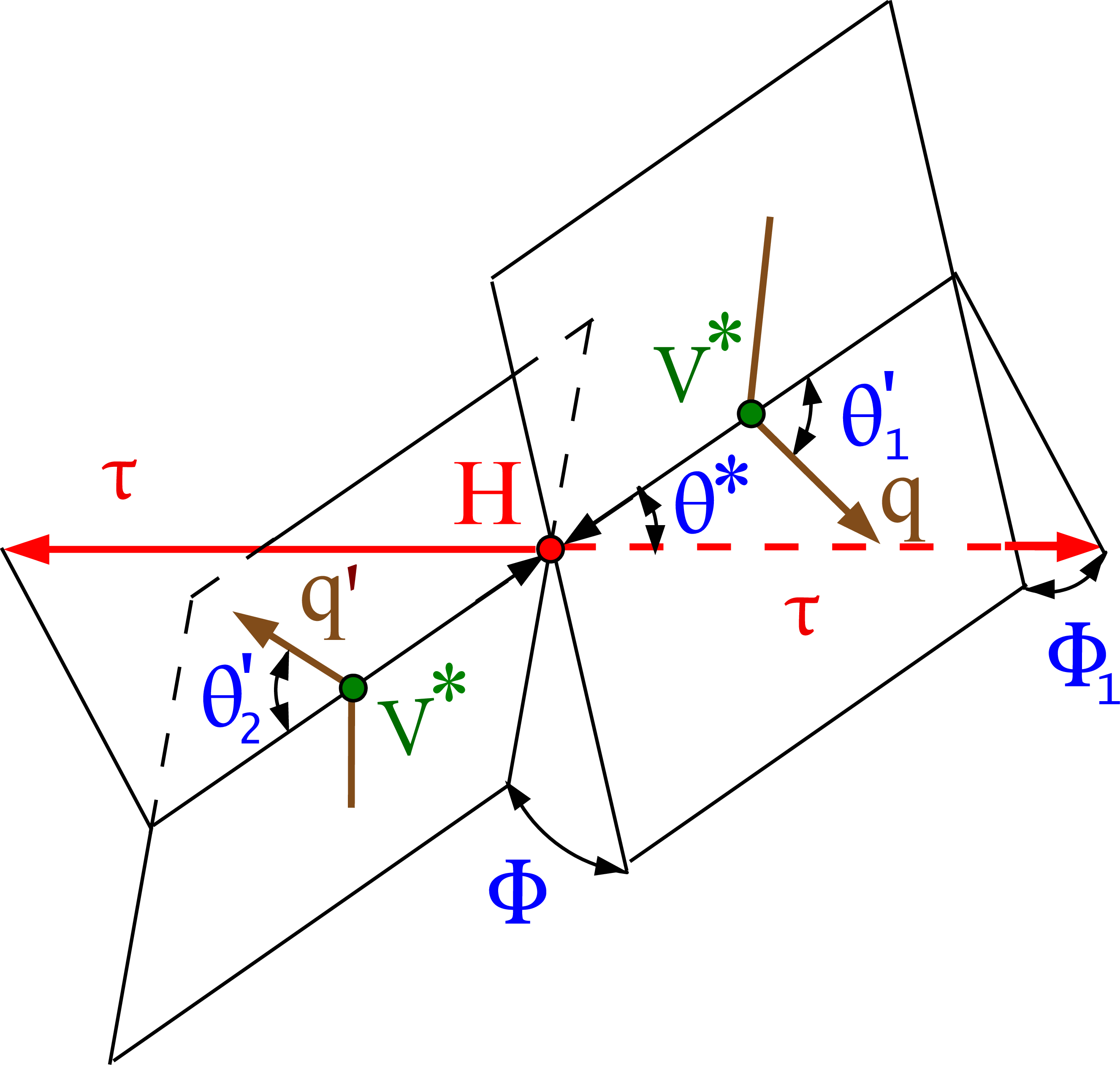
png pdf |
Figure 1-a:
Illustrations of H production in vector boson fusion qq′→qq′H (left) and qˉq′→V∗→VH (right). The decay H→ττ is shown without illustrating the further decay chain. Angles and invariant masses fully characterize the orientation of the production and two-body decay chain and are defined in the suitable rest frames [24,26]. |

png pdf |
Figure 1-b:
Illustrations of H production in vector boson fusion qq′→qq′H (left) and qˉq′→V∗→VH (right). The decay H→ττ is shown without illustrating the further decay chain. Angles and invariant masses fully characterize the orientation of the production and two-body decay chain and are defined in the suitable rest frames [24,26]. |

png pdf |
Figure 2:
Di-tau lepton candidate mass distribution (left) and pT spectrum of the selected H candidates (right) in the VBF category. All events selected in the eμ, eτh, μτh, and τhτh final states are included. Only statistical uncertainties are shown. |
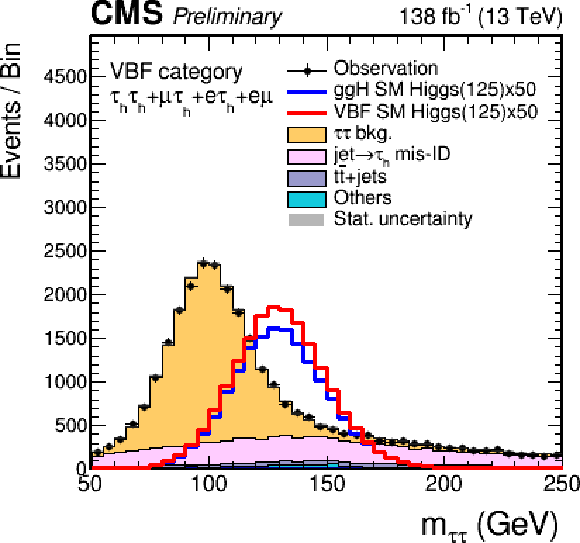
png pdf |
Figure 2-a:
Di-tau lepton candidate mass distribution (left) and pT spectrum of the selected H candidates (right) in the VBF category. All events selected in the eμ, eτh, μτh, and τhτh final states are included. Only statistical uncertainties are shown. |
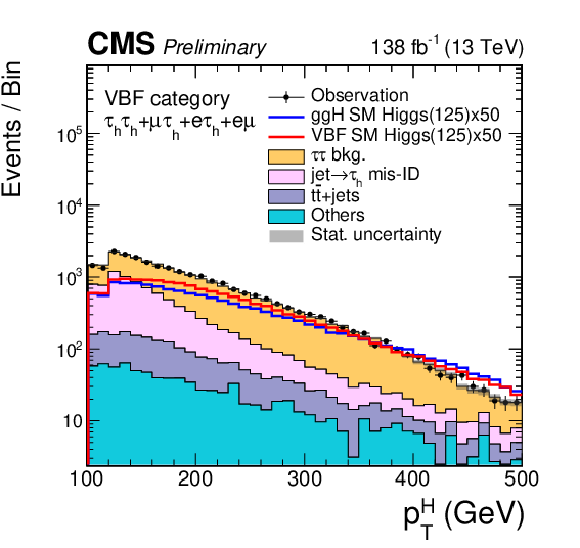
png pdf |
Figure 2-b:
Di-tau lepton candidate mass distribution (left) and pT spectrum of the selected H candidates (right) in the VBF category. All events selected in the eμ, eτh, μτh, and τhτh final states are included. Only statistical uncertainties are shown. |
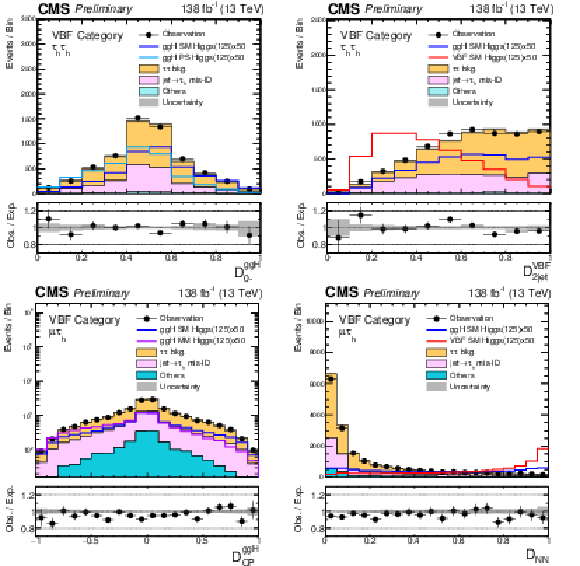
png pdf |
Figure 3:
Examples of data and signal and background predictions for MELA and neural network discriminants in the τhτh and μτh channels. Events passing the selections outlined in Section 5 and allocated to the VBF category are included. Only statistical uncertainties are shown. The expectation in the ratio plane is the sum of the estimated backgrounds and the SM H signal. For the DggH0− discriminant the distribution expected for a pseudoscalar H is overlaid to be compared to the SM signal. Similarly, for the DggHCP discriminant the distribution for a CP-violating scenario with maximum-mixing between CP-even and CP-odd couplings (labeled "MM" in the legend) is shown. |
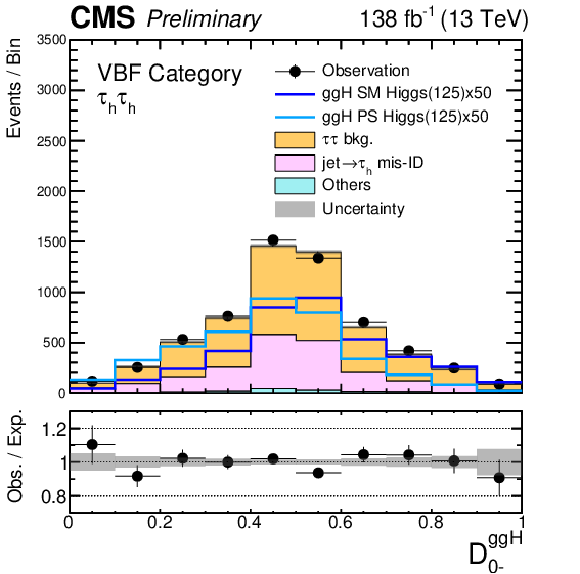
png pdf |
Figure 3-a:
Examples of data and signal and background predictions for MELA and neural network discriminants in the τhτh and μτh channels. Events passing the selections outlined in Section 5 and allocated to the VBF category are included. Only statistical uncertainties are shown. The expectation in the ratio plane is the sum of the estimated backgrounds and the SM H signal. For the DggH0− discriminant the distribution expected for a pseudoscalar H is overlaid to be compared to the SM signal. Similarly, for the DggHCP discriminant the distribution for a CP-violating scenario with maximum-mixing between CP-even and CP-odd couplings (labeled "MM" in the legend) is shown. |
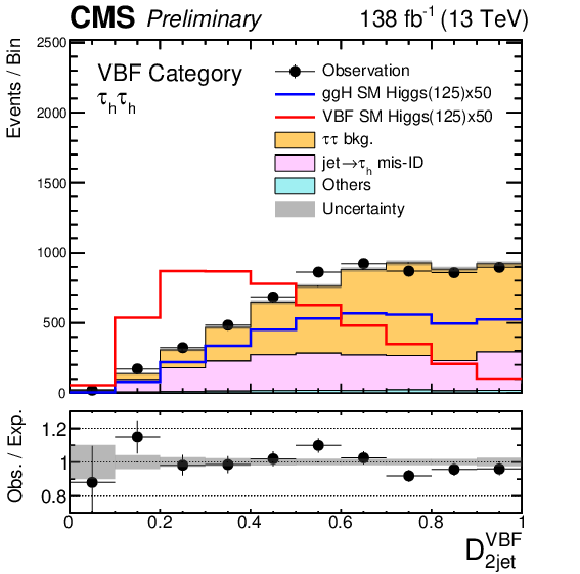
png pdf |
Figure 3-b:
Examples of data and signal and background predictions for MELA and neural network discriminants in the τhτh and μτh channels. Events passing the selections outlined in Section 5 and allocated to the VBF category are included. Only statistical uncertainties are shown. The expectation in the ratio plane is the sum of the estimated backgrounds and the SM H signal. For the DggH0− discriminant the distribution expected for a pseudoscalar H is overlaid to be compared to the SM signal. Similarly, for the DggHCP discriminant the distribution for a CP-violating scenario with maximum-mixing between CP-even and CP-odd couplings (labeled "MM" in the legend) is shown. |
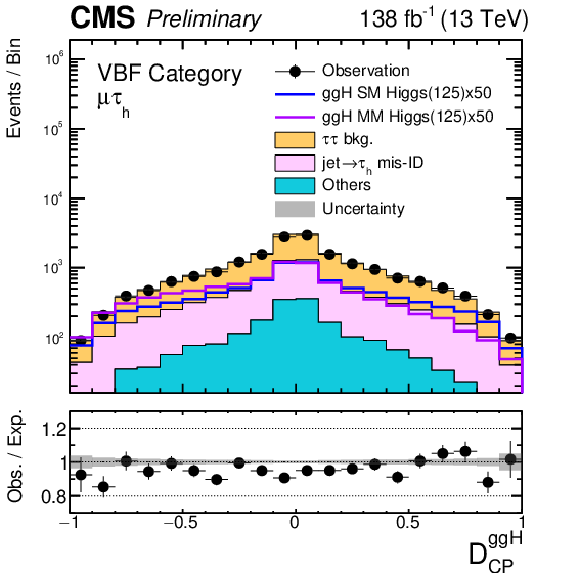
png pdf |
Figure 3-c:
Examples of data and signal and background predictions for MELA and neural network discriminants in the τhτh and μτh channels. Events passing the selections outlined in Section 5 and allocated to the VBF category are included. Only statistical uncertainties are shown. The expectation in the ratio plane is the sum of the estimated backgrounds and the SM H signal. For the DggH0− discriminant the distribution expected for a pseudoscalar H is overlaid to be compared to the SM signal. Similarly, for the DggHCP discriminant the distribution for a CP-violating scenario with maximum-mixing between CP-even and CP-odd couplings (labeled "MM" in the legend) is shown. |

png pdf |
Figure 3-d:
Examples of data and signal and background predictions for MELA and neural network discriminants in the τhτh and μτh channels. Events passing the selections outlined in Section 5 and allocated to the VBF category are included. Only statistical uncertainties are shown. The expectation in the ratio plane is the sum of the estimated backgrounds and the SM H signal. For the DggH0− discriminant the distribution expected for a pseudoscalar H is overlaid to be compared to the SM signal. Similarly, for the DggHCP discriminant the distribution for a CP-violating scenario with maximum-mixing between CP-even and CP-odd couplings (labeled "MM" in the legend) is shown. |

png pdf |
Figure 4:
The observed and predicted 2D distribution of (DggH0−, DNN) before the fit to data in the most sensitive VBF category region with 0.3 <DVBF2jet< 0.7 in the τhτh channel. The DggHCP>0 bins are shown in the plots, and the DggHCP< 0 side has a symmetric distribution except for small fluctuations in the observed data. Only the statistical uncertainties are included in the uncertainty band. |

png pdf |
Figure 5:
Observed and predicted 2D distributions after the fit to data in the VBF Tight-mjj boosted category in the τhτh channel. The uncertainty band accounts for all sources of systematic uncertainty on the signal and background predictions. The expectation in the ratio plane is the sum of the estimated backgrounds and the best fit signal. |
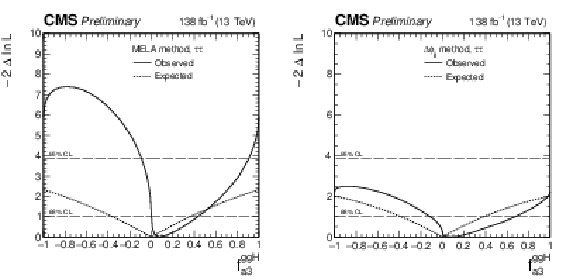
png pdf |
Figure 6:
Observed (solid) and expected (dashed) likelihood scans of fggHa3 obtained with the MELA method (left) and the Δϕjj method used as a cross check (right). |

png pdf |
Figure 6-a:
Observed (solid) and expected (dashed) likelihood scans of fggHa3 obtained with the MELA method (left) and the Δϕjj method used as a cross check (right). |
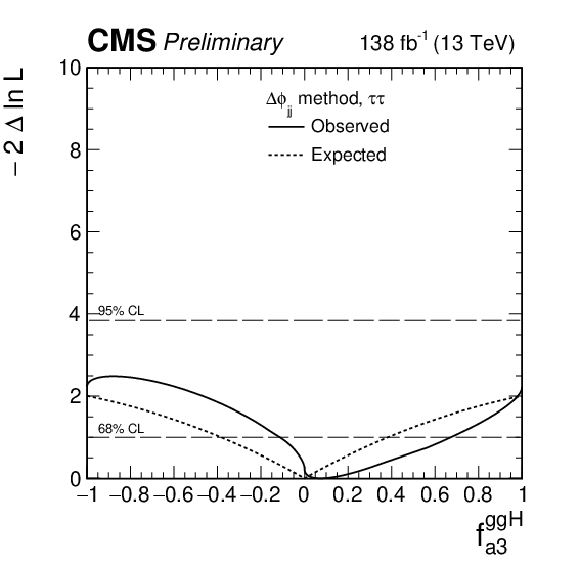
png pdf |
Figure 6-b:
Observed (solid) and expected (dashed) likelihood scans of fggHa3 obtained with the MELA method (left) and the Δϕjj method used as a cross check (right). |

png pdf |
Figure 7:
Observed (solid) and expected (dashed) likelihood scans of αHff obtained with the MELA method (left) and the Δϕjj method used as a cross check (right). |

png pdf |
Figure 7-a:
Observed (solid) and expected (dashed) likelihood scans of αHff obtained with the MELA method (left) and the Δϕjj method used as a cross check (right). |

png pdf |
Figure 7-b:
Observed (solid) and expected (dashed) likelihood scans of αHff obtained with the MELA method (left) and the Δϕjj method used as a cross check (right). |
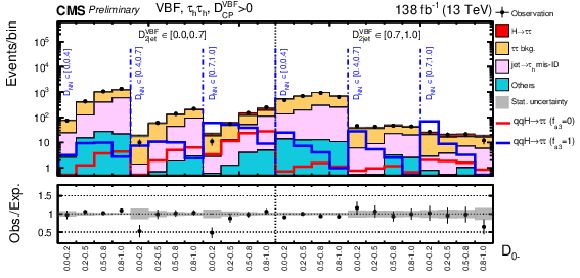
png pdf |
Figure 8:
The observed and predicted 3D distribution of (D0−,DNN, DVBF2jet) before the fit to data in the τhτh channel for the most sensitive VBF category. The DVBFCP>0 bins are shown in the plots, and the DVBFCP< 0 side has a symmetric distribution except for small fluctuation in the observations. Only the statistical uncertainties are included in the uncertainty band. |
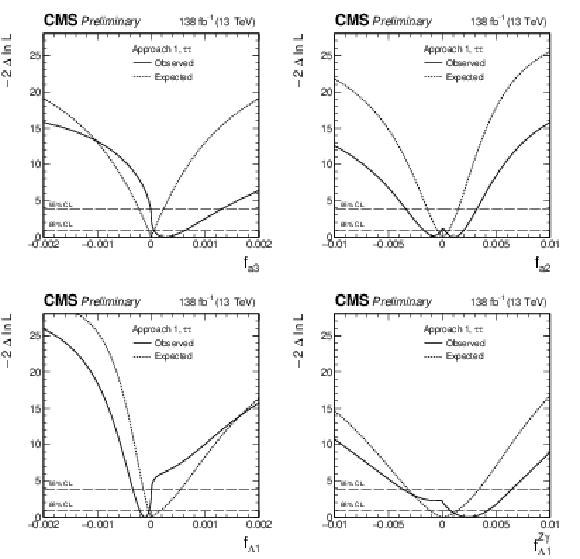
png pdf |
Figure 9:
Observed (solid) and expected (dashed) likelihood scans of fa3 (top left), fa2 (top right), fΛ1 (bottom left), and fZγΛ1 (bottom right) in Approach 1 (aWWi=aZZi). |
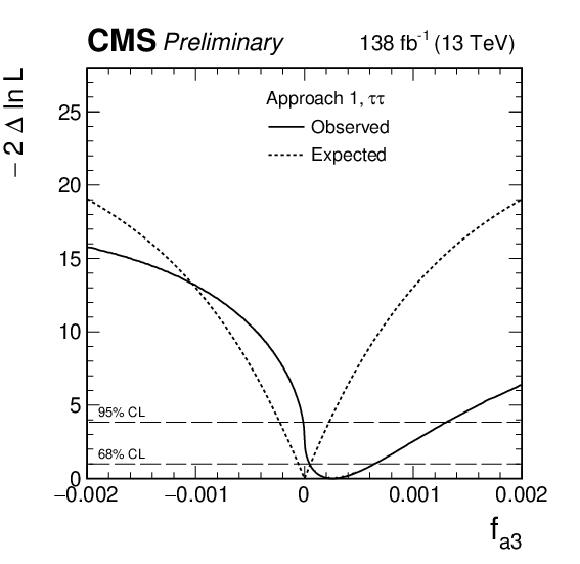
png pdf |
Figure 9-a:
Observed (solid) and expected (dashed) likelihood scans of fa3 (top left), fa2 (top right), fΛ1 (bottom left), and fZγΛ1 (bottom right) in Approach 1 (aWWi=aZZi). |
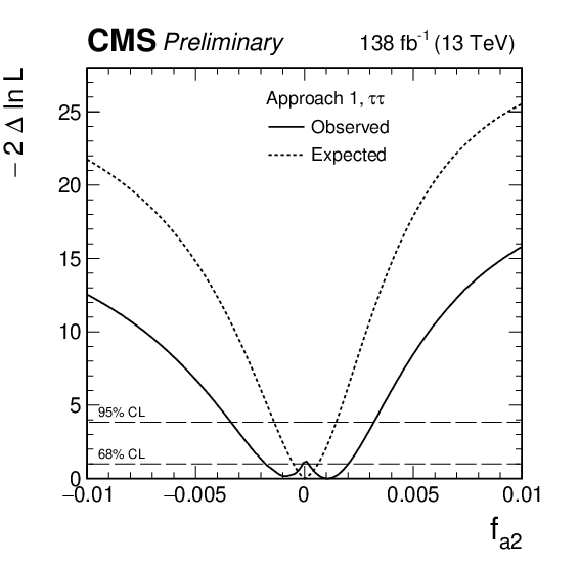
png pdf |
Figure 9-b:
Observed (solid) and expected (dashed) likelihood scans of fa3 (top left), fa2 (top right), fΛ1 (bottom left), and fZγΛ1 (bottom right) in Approach 1 (aWWi=aZZi). |

png pdf |
Figure 9-c:
Observed (solid) and expected (dashed) likelihood scans of fa3 (top left), fa2 (top right), fΛ1 (bottom left), and fZγΛ1 (bottom right) in Approach 1 (aWWi=aZZi). |
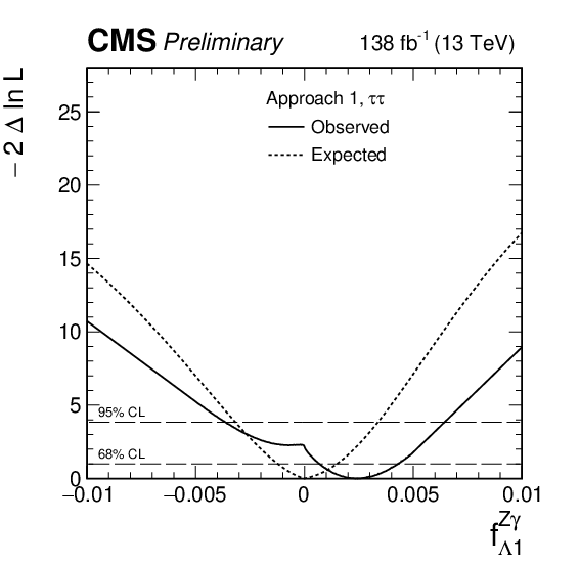
png pdf |
Figure 9-d:
Observed (solid) and expected (dashed) likelihood scans of fa3 (top left), fa2 (top right), fΛ1 (bottom left), and fZγΛ1 (bottom right) in Approach 1 (aWWi=aZZi). |

png pdf |
Figure 10:
Observed (solid) and expected (dashed) likelihood scans of fa3 in Approach 2. |
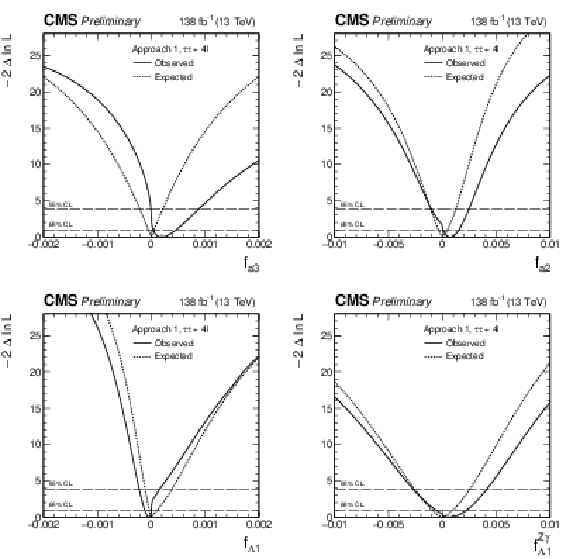
png pdf |
Figure 11:
Observed (solid) and expected (dashed) likelihood scans of fa3 (top left), fa2 (top right), fΛ1 (bottom left), and fZγΛ1 (bottom right) in Approach 1 (aWWi = aZZi) obtained with the combination of results using the H→ττ and H→4ℓ [21] decay channels. |
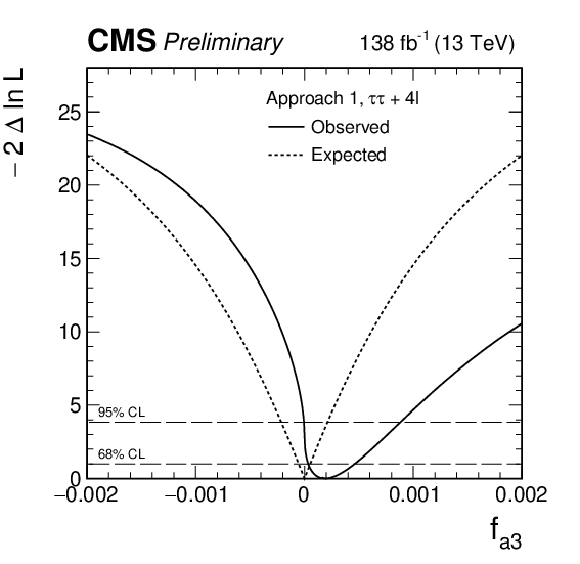
png pdf |
Figure 11-a:
Observed (solid) and expected (dashed) likelihood scans of fa3 (top left), fa2 (top right), fΛ1 (bottom left), and fZγΛ1 (bottom right) in Approach 1 (aWWi = aZZi) obtained with the combination of results using the H→ττ and H→4ℓ [21] decay channels. |

png pdf |
Figure 11-b:
Observed (solid) and expected (dashed) likelihood scans of fa3 (top left), fa2 (top right), fΛ1 (bottom left), and fZγΛ1 (bottom right) in Approach 1 (aWWi = aZZi) obtained with the combination of results using the H→ττ and H→4ℓ [21] decay channels. |

png pdf |
Figure 11-c:
Observed (solid) and expected (dashed) likelihood scans of fa3 (top left), fa2 (top right), fΛ1 (bottom left), and fZγΛ1 (bottom right) in Approach 1 (aWWi = aZZi) obtained with the combination of results using the H→ττ and H→4ℓ [21] decay channels. |
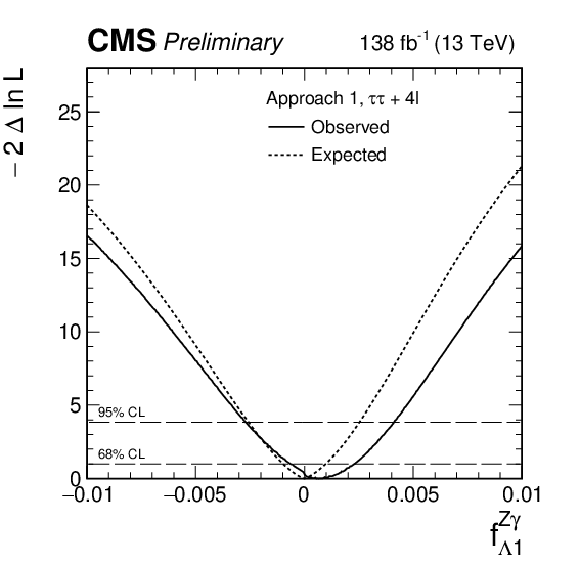
png pdf |
Figure 11-d:
Observed (solid) and expected (dashed) likelihood scans of fa3 (top left), fa2 (top right), fΛ1 (bottom left), and fZγΛ1 (bottom right) in Approach 1 (aWWi = aZZi) obtained with the combination of results using the H→ττ and H→4ℓ [21] decay channels. |
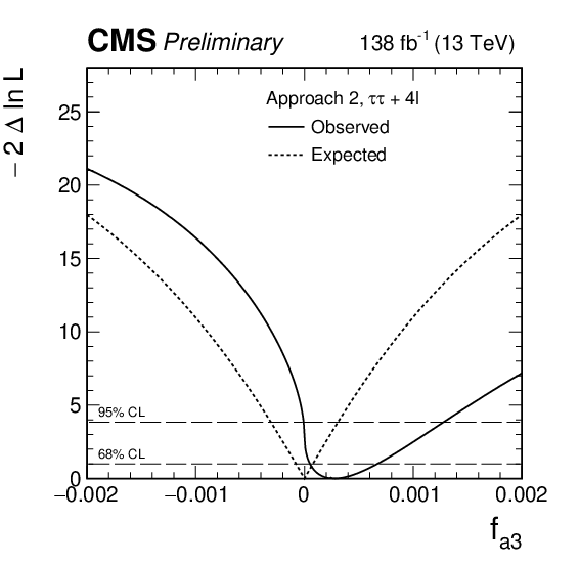
png pdf |
Figure 12:
Observed (solid) and expected (dashed) likelihood scans of fa3 in Approach 2 (defined in Section 2) obtained with the combination of results using the H→ττ and H→4ℓ [21] decay channels. |
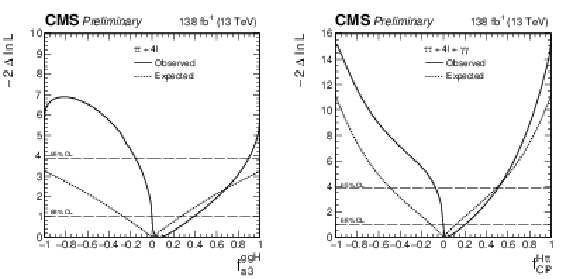
png pdf |
Figure 13:
Left: the observed (solid) and expected (dashed) likelihood scans of fggHa3 and αHff obtained with the combination of results using the H→ττ and H→4ℓ [21] decay channels. Right: The observed (solid) and expected (dashed) likelihood scans of fHttCP obtained with the combination of results using the H→ττ, H→4ℓ [21], and H→γγ [22] decay channels. |

png pdf |
Figure 13-a:
Left: the observed (solid) and expected (dashed) likelihood scans of fggHa3 and αHff obtained with the combination of results using the H→ττ and H→4ℓ [21] decay channels. Right: The observed (solid) and expected (dashed) likelihood scans of fHttCP obtained with the combination of results using the H→ττ, H→4ℓ [21], and H→γγ [22] decay channels. |
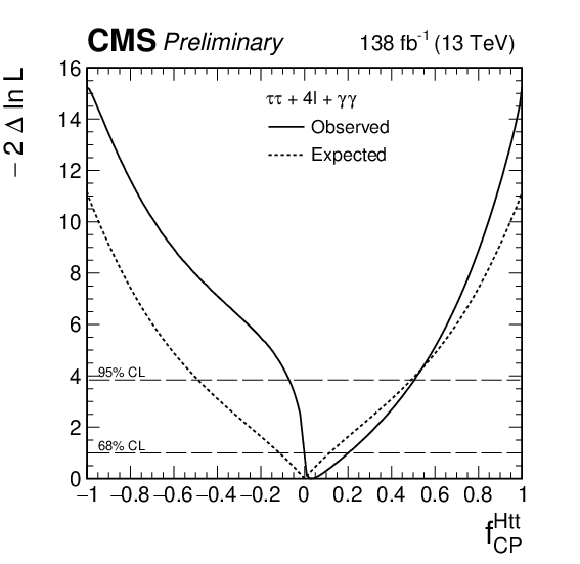
png pdf |
Figure 13-b:
Left: the observed (solid) and expected (dashed) likelihood scans of fggHa3 and αHff obtained with the combination of results using the H→ττ and H→4ℓ [21] decay channels. Right: The observed (solid) and expected (dashed) likelihood scans of fHttCP obtained with the combination of results using the H→ττ, H→4ℓ [21], and H→γγ [22] decay channels. |

png pdf |
Figure 14:
Observed (solid) and expected (dashed) likelihood scans of cgg (left) and ˜cgg (right) with κt and ˜κt profiled (top) and fixed to SM expectation (bottom) using the H→ττ, H→4ℓ [21], and H→γγ [22] decay channels. |
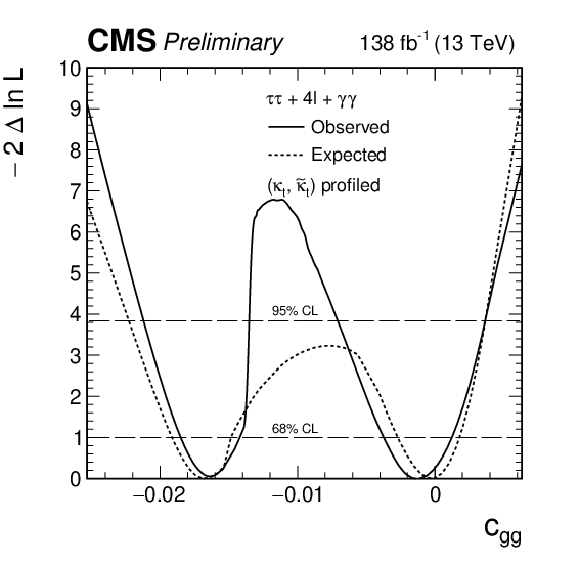
png pdf |
Figure 14-a:
Observed (solid) and expected (dashed) likelihood scans of cgg (left) and ˜cgg (right) with κt and ˜κt profiled (top) and fixed to SM expectation (bottom) using the H→ττ, H→4ℓ [21], and H→γγ [22] decay channels. |
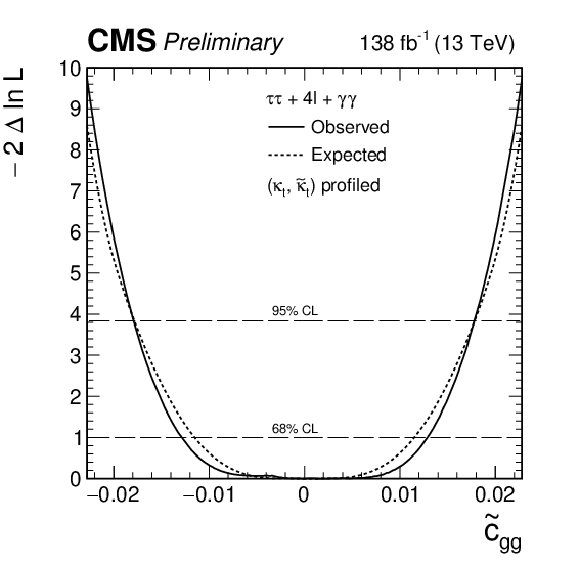
png pdf |
Figure 14-b:
Observed (solid) and expected (dashed) likelihood scans of cgg (left) and ˜cgg (right) with κt and ˜κt profiled (top) and fixed to SM expectation (bottom) using the H→ττ, H→4ℓ [21], and H→γγ [22] decay channels. |

png pdf |
Figure 14-c:
Observed (solid) and expected (dashed) likelihood scans of cgg (left) and ˜cgg (right) with κt and ˜κt profiled (top) and fixed to SM expectation (bottom) using the H→ττ, H→4ℓ [21], and H→γγ [22] decay channels. |
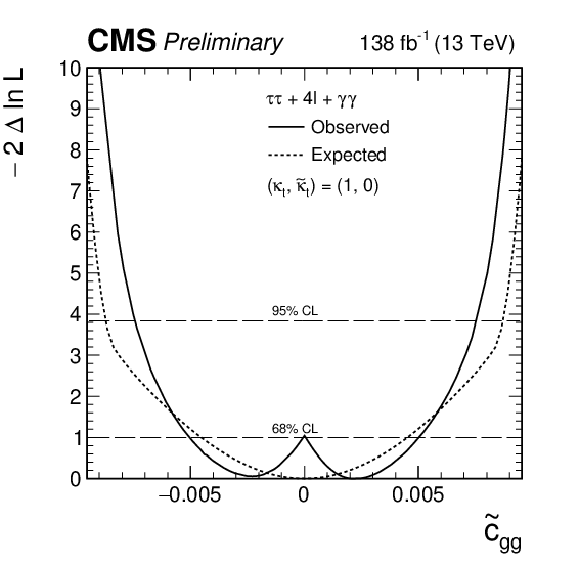
png pdf |
Figure 14-d:
Observed (solid) and expected (dashed) likelihood scans of cgg (left) and ˜cgg (right) with κt and ˜κt profiled (top) and fixed to SM expectation (bottom) using the H→ττ, H→4ℓ [21], and H→γγ [22] decay channels. |
| Tables | |
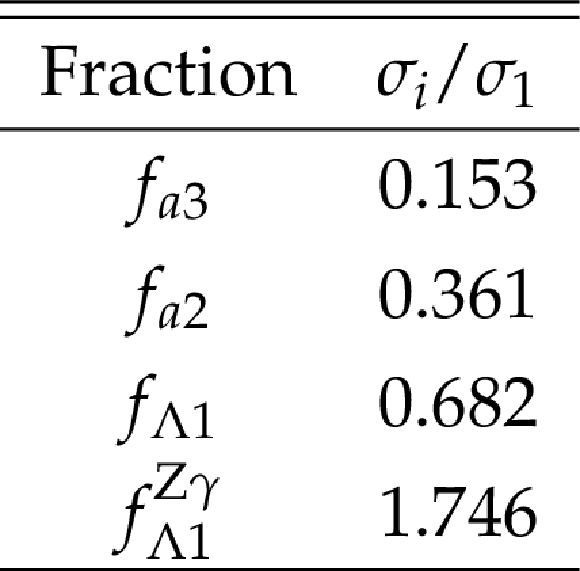
png pdf |
Table 1:
The cross sections for the anomalous contributions used to define the fractional cross sections. All cross sections are given relative to the SM value (σ1). In the case of the κ1 and κZγ2 couplings, the numerical values Λ1=ΛZγ1= 100 GeV are considered so as to keep all coefficients of similar order of magnitude. |

png pdf |
Table 2:
Kinematic selection requirements for the four di-τ decay channels. The trigger requirement is defined by a combination of trigger candidates with pT over a given threshold, indicated inside parentheses in GeV. The pseudorapidity thresholds come from trigger and object reconstruction constraints. The pT thresholds for the lepton selection are driven by the trigger requirements, except for the τh candidate in the μτh and eτh channels, and the sub-leading lepton in the eμ channel, where they have been optimized to increase the analysis sensitivity. |
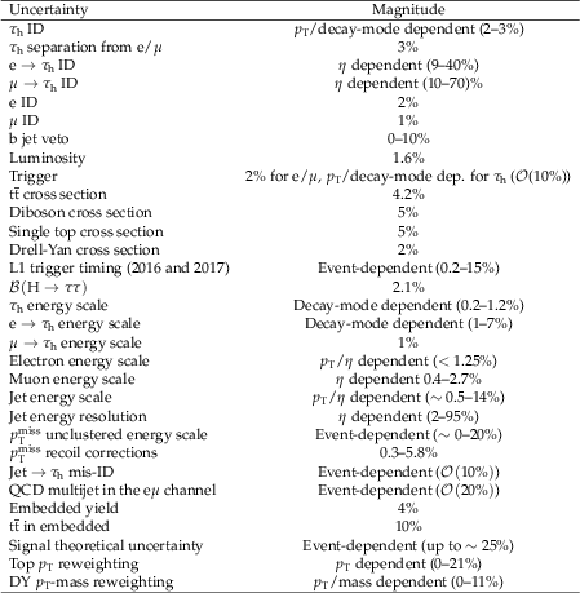
png pdf |
Table 3:
Sources of systematic uncertainties. |

png pdf |
Table 4:
List of observables used in the MELA method. |

png pdf |
Table 5:
List of observables used in the Δϕjj method. |

png pdf |
Table 6:
Allowed 68% CL (central values with uncertainties) and 95% CL (in square brackets) intervals on anomalous ggH coupling parameters using the H→ττ decay. The use of "-" indicates cases where no exclusion at the 95% CL was found. As indicated in the Table, the results are presented for the MELA method, as well as the Δϕjj method for comparison. The final results of this study are from the MELA method. |

png pdf |
Table 7:
Allowed 68% CL (central values with uncertainties) and 95% CL (in square brackets) intervals on anomalous HVV coupling parameters using the H→ττ decay. Approaches 1 and 2 refer to the choice of the relationship between the aWWi and aZZi couplings, defined in Section 2. |

png pdf |
Table 8:
Allowed 68% CL (central values with uncertainties) and 95% CL (in square brackets) intervals on anomalous HVV coupling parameters using the H→ττ and H→4ℓ [21] decay channels, using two approaches described in Section 2 that define the relationship between the aWWi and aZZi couplings. |

png pdf |
Table 9:
Allowed 68% CL (central values with uncertainties) and 95% CL (in square brackets) intervals on fggHa3, from the combination of the H→ττ and H→4ℓ [21] decay channels, and fHttCP, from the combination of the H→ττ, H→4ℓ [21], and H→γγ [22] decay channels. |

png pdf |
Table 10:
Allowed 68% CL (central values with uncertainties) and 95% CL (in square brackets) intervals on cgg and ˜cgg using the H→ττ, H→4ℓ [21], and H→γγ [22] decay channels. Results are presented for two scenarios: κt and ˜κt profiled in the fit, and κt and ˜κt fixed to the SM expectation. |
| Summary |
| A study is presented of anomalous interactions of the H boson with vector bosons, including CP violation, using its associated production with two hadronic jets in gluon fusion, vector boson fusion, and associated production with a vector boson, and a subsequent decay to a pair of τ leptons. Constraints have been set on the CP violating effects in ggH production in terms of the effective cross section ratio fggHa3 and mixing angle αHff using both azimuthal correlations of the two leading hadronic jets in the events and matrix element techniques. Both methods yield comparable expected sensitivities and result in the most stringent limits on CP violation in ggH production followed by H→ττ decays to date. In the VBF and VH production analysis, constraints on the CP-violating parameter fa3 and on the CP-conserving parameters fa2, fΛ1, and fZγΛ1 have been set using matrix element techniques. Further constraints were obtained in the combination of the H→ττ, H→4ℓ, and H→γγ final states. The combination improves the limits on the anomalous coupling parameters typically by about 20-50%. The analysis excludes the pure CP-odd Hgg coupling scenario with a significance in excess of 2σ for the first time. |
| References | ||||
| 1 | ATLAS Collaboration | Observation of a new particle in the search for the standard model Higgs boson with the ATLAS detector at the LHC | PLB 716 (2012) 1 | 1207.7214 |
| 2 | CMS Collaboration | Observation of a new boson at a mass of 125 GeV with the CMS experiment at the LHC | PLB 716 (2012) 30 | CMS-HIG-12-028 1207.7235 |
| 3 | CMS Collaboration | Observation of a new boson with mass near 125 GeV in pp collisions at √s= 7 and 8 TeV | JHEP 06 (2013) 081 | CMS-HIG-12-036 1303.4571 |
| 4 | S. L. Glashow | Partial-symmetries of weak interactions | NP 22 (1961) 579 | |
| 5 | F. Englert and R. Brout | Broken symmetry and the mass of gauge vector mesons | PRL 13 (1964) 321 | |
| 6 | P. W. Higgs | Broken symmetries, massless particles and gauge fields | PL12 (1964) 132 | |
| 7 | P. W. Higgs | Broken symmetries and the masses of gauge bosons | PRL 13 (1964) 508 | |
| 8 | G. S. Guralnik, C. R. Hagen, and T. W. B. Kibble | Global conservation laws and massless particles | PRL 13 (1964) 585 | |
| 9 | S. Weinberg | A model of leptons | PRL 19 (1967) 1264 | |
| 10 | A. Salam | Weak and electromagnetic interactions | Conf. Proc. C 680519 (1968) 367 | |
| 11 | CMS Collaboration | Constraints on the spin-parity and anomalous HVV couplings of the Higgs boson in proton collisions at 7 and 8 TeV | PRD 92 (2015) 012004 | CMS-HIG-14-018 1411.3441 |
| 12 | ATLAS Collaboration | Study of the spin and parity of the Higgs boson in diboson decays with the ATLAS detector | EPJC 75 (2015) 476 | 1506.05669 |
| 13 | CMS Collaboration | Study of the mass and spin-parity of the Higgs boson candidate via its decays to Z boson pairs | PRL 110 (2013) 081803 | CMS-HIG-12-041 1212.6639 |
| 14 | CMS Collaboration | Measurement of the properties of a Higgs boson in the four-lepton final state | PRD 89 (2014) 092007 | CMS-HIG-13-002 1312.5353 |
| 15 | CMS Collaboration | Limits on the Higgs boson lifetime and width from its decay to four charged leptons | PRD 92 (2015) 072010 | CMS-HIG-14-036 1507.06656 |
| 16 | CMS Collaboration | Combined search for anomalous pseudoscalar HVV couplings in VH(H →bˉb) production and H → VV decay | PLB 759 (2016) 672 | CMS-HIG-14-035 1602.04305 |
| 17 | CMS Collaboration | Constraints on anomalous Higgs boson couplings using production and decay information in the four-lepton final state | PLB 775 (2017) 1 | CMS-HIG-17-011 1707.00541 |
| 18 | CMS Collaboration | Measurements of the Higgs boson width and anomalous HVV couplings from on-shell and off-shell production in the four-lepton final state | PRD 99 (2019) 112003 | CMS-HIG-18-002 1901.00174 |
| 19 | CMS Collaboration | Constraints on anomalous HVV couplings from the production of Higgs bosons decaying to τ lepton pairs | PRD 100 (2019) 112002 | CMS-HIG-17-034 1903.06973 |
| 20 | ATLAS Collaboration | Constraints on Higgs boson properties using WW∗(→eνμν)jj production in 36.1 fb−1 of √s= 13 TeV pp collisions with the ATLAS detector | Submitted to EPJC | 2109.13808 |
| 21 | CMS Collaboration | Constraints on anomalous Higgs boson couplings to vector bosons and fermions in its production and decay using the four-lepton final state | PRD 104 (2021) 052004 | CMS-HIG-19-009 2104.12152 |
| 22 | CMS Collaboration | Measurements of tˉtH production and the CP structure of the Yukawa interaction between the Higgs boson and top quark in the diphoton decay channel | PRL 125 (2020) 061801 | CMS-HIG-19-013 2003.10866 |
| 23 | ATLAS Collaboration | CP properties of Higgs boson interactions with top quarks in the tˉtH and tH processes using H→γγ with the ATLAS detector | PRL 125 (2020) 061802 | 2004.04545 |
| 24 | Y. Gao et al. | Spin determination of single-produced resonances at hadron colliders | PRD 81 (2010) 075022 | 1001.3396 |
| 25 | S. Bolognesi et al. | Spin and parity of a single-produced resonance at the LHC | PRD 86 (2012) 095031 | 1208.4018 |
| 26 | I. Anderson et al. | Constraining anomalous HVV interactions at proton and lepton colliders | PRD 89 (2014) 035007 | 1309.4819 |
| 27 | A. V. Gritsan, R. Rontsch, M. Schulze, and M. Xiao | Constraining anomalous Higgs boson couplings to the heavy flavor fermions using matrix element techniques | PRD 94 (2016) 055023 | 1606.03107 |
| 28 | F. Chollet et al. | keras | link | |
| 29 | T. Plehn, D. L. Rainwater, and D. Zeppenfeld | Determining the structure of Higgs couplings at the LHC | PRL 88 (2002) 051801 | hep-ph/0105325 |
| 30 | V. Hankele, G. Klamke, D. Zeppenfeld, and T. Figy | Anomalous Higgs boson couplings in vector boson fusion at the CERN LHC | PRD 74 (2006) 095001 | hep-ph/0609075 |
| 31 | E. Accomando et al. | Workshop on CP studies and non-standard Higgs physics | hep-ph/0608079 | |
| 32 | K. Hagiwara, Q. Li, and K. Mawatari | Jet angular correlation in vector-boson fusion processes at hadron colliders | JHEP 07 (2009) 101 | 0905.4314 |
| 33 | A. De R\' ujula et al. | Higgs look-alikes at the LHC | PRD 82 (2010) 013003 | 1001.5300 |
| 34 | J. Ellis, D. S. Hwang, V. Sanz, and T. You | A fast track towards the `Higgs' spin and parity | JHEP 11 (2012) 134 | 1208.6002 |
| 35 | P. Artoisenet et al. | A framework for Higgs characterisation | JHEP 11 (2013) 043 | 1306.6464 |
| 36 | M. J. Dolan, P. Harris, M. Jankowiak, and M. Spannowsky | Constraining CP-violating Higgs sectors at the LHC using gluon fusion | PRD 90 (2014) 073008 | 1406.3322 |
| 37 | A. Greljo, G. Isidori, J. M. Lindert, and D. Marzocca | Pseudo-observables in electroweak Higgs production | EPJC 76 (2016) 158 | 1512.06135 |
| 38 | A. V. Gritsan et al. | New features in the JHU generator framework: constraining Higgs boson properties from on-shell and off-shell production | PRD 102 (2020) 056022 | 2002.09888 |
| 39 | LHC Higgs Cross Section Working Group | Handbook of LHC Higgs cross sections: 4. deciphering the nature of the Higgs sector | CERN (2016) | 1610.07922 |
| 40 | J. Davis et al. | Constraining anomalous Higgs boson couplings to virtual photons | 2109.13363 | |
| 41 | ATLAS Collaboration | Evidence for the spin-0 nature of the Higgs boson using ATLAS data | PLB 726 (2013) 120 | 1307.1432 |
| 42 | ATLAS Collaboration | Test of CP invariance in vector-boson fusion production of the Higgs boson using the optimal observable method in the ditau decay channel with the ATLAS detector | EPJC 76 (2016) 658 | 1602.04516 |
| 43 | ATLAS Collaboration | Measurement of inclusive and differential cross sections in the H→ZZ∗→4ℓ decay channel in pp collisions at √s= 13 TeV with the ATLAS detector | JHEP 10 (2017) 132 | 1708.02810 |
| 44 | ATLAS Collaboration | Measurement of the Higgs boson coupling properties in the H→ZZ∗→4ℓ decay channel at √s= 13 TeV with the ATLAS detector | JHEP 03 (2018) 095 | 1712.02304 |
| 45 | ATLAS Collaboration | Measurements of Higgs boson properties in the diphoton decay channel with 36 fb−1 of pp collision data at √s= 13 TeV with the ATLAS detector | PRD 98 (2018) 052005 | 1802.04146 |
| 46 | ATLAS Collaboration | Test of CP invariance in vector-boson fusion production of the Higgs boson in the H→ττ channel in proton−proton collisions at √s= 13 TeV with the ATLAS detector | PLB 805 (2020) 135426 | 2002.05315 |
| 47 | G. Klamke and D. Zeppenfeld | Higgs plus two jet production via gluon fusion as a signal at the CERN LHC | JHEP 04 (2007) 052 | hep-ph/0703202 |
| 48 | CMS Collaboration | The CMS trigger system | JINST 12 (2017) P01020 | CMS-TRG-12-001 1609.02366 |
| 49 | CMS Collaboration | The CMS experiment at the CERN LHC | JINST 3 (2008) S08004 | CMS-00-001 |
| 50 | CMS Collaboration | Precision luminosity measurement in proton-proton collisions at √s= 13 TeV in 2015 and 2016 at CMS | EPJC 81 (2021) 800 | CMS-LUM-17-003 2104.01927 |
| 51 | CMS Collaboration | CMS luminosity measurement for the 2017 data-taking period at √s= 13 TeV | CMS-PAS-LUM-17-004 | CMS-PAS-LUM-17-004 |
| 52 | CMS Collaboration | CMS luminosity measurement for the 2018 data-taking period at √s= 13 TeV | CMS-PAS-LUM-18-002 | CMS-PAS-LUM-18-002 |
| 53 | T. Sjostrand et al. | An introduction to PYTHIA 8.2 | CPC 191 (2015) 159 | 1410.3012 |
| 54 | CMS Collaboration | Event generator tunes obtained from underlying event and multiparton scattering measurements | EPJC 76 (2016) 155 | CMS-GEN-14-001 1512.00815 |
| 55 | CMS Collaboration | Extraction and validation of a new set of CMS PYTHIA8 tunes from underlying-event measurements | EPJC 80 (2020) 4 | CMS-GEN-17-001 1903.12179 |
| 56 | NNPDF Collaboration | Parton distributions for the LHC Run II | JHEP 04 (2015) 040 | 1410.8849 |
| 57 | NNPDF Collaboration | Parton distributions from high-precision collider data | EPJC 77 (2017) 663 | 1706.00428 |
| 58 | GEANT4 Collaboration | GEANT4--a simulation toolkit | NIMA 506 (2003) 250 | |
| 59 | P. Nason | A new method for combining NLO QCD with shower Monte Carlo algorithms | JHEP 11 (2004) 040 | hep-ph/0409146 |
| 60 | S. Frixione, P. Nason, and C. Oleari | Matching NLO QCD computations with parton shower simulations: the POWHEG method | JHEP 11 (2007) 070 | 0709.2092 |
| 61 | S. Alioli, P. Nason, C. Oleari, and E. Re | A general framework for implementing NLO calculations in shower Monte Carlo programs: the POWHEG BOX | JHEP 06 (2010) 043 | 1002.2581 |
| 62 | P. Nason and C. Oleari | NLO Higgs boson production via vector-boson fusion matched with shower in POWHEG | JHEP 02 (2010) 037 | 0911.5299 |
| 63 | T. Je\vzo and P. Nason | On the Treatment of Resonances in Next-to-Leading Order Calculations Matched to a Parton Shower | JHEP 12 (2015) 065 | 1509.09071 |
| 64 | F. Granata, J. M. Lindert, C. Oleari, and S. Pozzorini | NLO QCD+EW predictions for HV and HV +jet production including parton-shower effects | JHEP 09 (2017) 012 | 1706.03522 |
| 65 | J. Alwall et al. | The automated computation of tree-level and next-to-leading order differential cross sections, and their matching to parton shower simulations | JHEP 07 (2014) 079 | 1405.0301 |
| 66 | R. Frederix and S. Frixione | Merging meets matching in MC@NLO | JHEP 12 (2012) 061 | 1209.6215 |
| 67 | F. Demartin et al. | Higgs characterisation at NLO in QCD: CP properties of the top-quark Yukawa interaction | EPJC74 (2014) 3065 | 1407.5089 |
| 68 | K. Hamilton, P. Nason, E. Re, and G. Zanderighi | NNLOPS simulation of Higgs boson production | JHEP 10 (2013) 222 | 1309.0017 |
| 69 | K. Hamilton, P. Nason, and G. Zanderighi | Finite quark-mass effects in the NNLOPS POWHEG+MiNLO Higgs generator | JHEP 05 (2015) 140 | 1501.04637 |
| 70 | J. Alwall et al. | Comparative study of various algorithms for the merging of parton showers and matrix elements in hadronic collisions | EPJC 53 (2008) 473 | 0706.2569 |
| 71 | S. Alioli, S.-O. Moch, and P. Uwer | Hadronic top-quark pair-production with one jet and parton showering | JHEP 01 (2012) 137 | 1110.5251 |
| 72 | R. Frederix, E. Re, and P. Torrielli | Single-top t-channel hadroproduction in the four-flavour scheme with POWHEG and aMC@NLO | JHEP 09 (2012) 130 | 1207.5391 |
| 73 | E. Re | Single-top Wt-channel production matched with parton showers using the POWHEG method | EPJC 71 (2011) 1547 | 1009.2450 |
| 74 | CMS Collaboration | Particle-flow reconstruction and global event description with the CMS detector | JINST 12 (2017) P10003 | CMS-PRF-14-001 1706.04965 |
| 75 | M. Cacciari, G. P. Salam, and G. Soyez | The anti-kT jet clustering algorithm | JHEP 04 (2008) 063 | 0802.1189 |
| 76 | M. Cacciari, G. P. Salam, and G. Soyez | FastJet user manual | EPJC 72 (2012) 1896 | 1111.6097 |
| 77 | CMS Collaboration | Performance of electron reconstruction and selection with the CMS detector in proton-proton collisions at √s= 8 TeV | JINST 10 (2015) P06005 | CMS-EGM-13-001 1502.02701 |
| 78 | CMS Collaboration | Performance of the CMS muon detector and muon reconstruction with proton-proton collisons at √s= ~13 TeV | JINST 13 (2018) P06015 | CMS-MUO-16-001 1804.04528 |
| 79 | M. Cacciari, G. P. Salam | Dispelling the N3 myth for the kt jet-finder | PLB 641 (2006) 57 | hep-ph/0512210 |
| 80 | CMS Collaboration | Identification of heavy-flavour jets with the CMS detector in pp collisions at 13 TeV | JINST 13 (2018) P05011 | CMS-BTV-16-002 1712.07158 |
| 81 | CMS Collaboration | Reconstruction and identification of τ lepton decays to hadrons and ντ at CMS | JINST 11 (2016) P01019 | CMS-TAU-14-001 1510.07488 |
| 82 | CMS Collaboration | Performance of reconstruction and identification of τ leptons decaying to hadrons and ντ in pp collisions at √s= 13 TeV | JINST 13 (2018) P10005 | CMS-TAU-16-003 1809.02816 |
| 83 | CMS Collaboration | Performance of the DeepTau algorithm for the discrimination of taus against jets, electron, and muons | CDS | |
| 84 | CMS Collaboration | Performance of missing transverse momentum in pp collisions at √s= 13 TeV using the CMS detector | CDS | |
| 85 | L. Bianchini, J. Conway, E. K. Friis, and C. Veelken | Reconstruction of the Higgs mass in H→ττ events by dynamical likelihood techniques | J. Phys. Conf. Ser. 513 (2014) 022035 | |
| 86 | D. Jang | Search for MSSM Higgs decaying to τ pairs in pˉp collision at √s= 1.96 TeV at CDF | PhD thesis, Rutgers U., Piscataway | |
| 87 | CMS Collaboration | Observation of the Higgs boson decay to a pair of τ leptons with the CMS detector | PLB 779 (2018) 283 | CMS-HIG-16-043 1708.00373 |
| 88 | CMS Collaboration | An embedding technique to determine ττ backgrounds in proton-proton collision data | JINST 14 (2019) P06032 | CMS-TAU-18-001 1903.01216 |
| 89 | CMS Collaboration | Measurement of the Zγ∗→ττ cross section in pp collisions at √s= 13 TeV and validation of τ lepton analysis techniques | EPJC 78 (2018) 708 | CMS-HIG-15-007 1801.03535 |
| 90 | CMS Collaboration | Measurement of the differential cross section for top quark pair production in pp collisions at √s= 8 TeV | EPJC 75 (2015) 542 | CMS-TOP-12-028 1505.04480 |
| 91 | V. Hankele, G. Klamke, and D. Zeppenfeld | Higgs + 2 jets as a probe for CP properties | hep-ph/0605117 | |

|
Compact Muon Solenoid LHC, CERN |

|

|

|

|

|

|